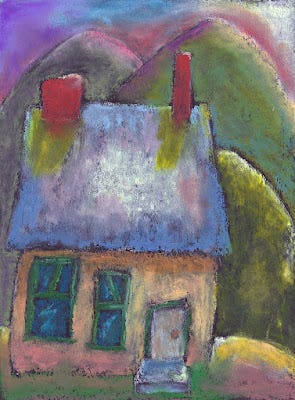Visual art is everywhere: TV, internet, phone, streaming, there are graphic representations bombarding us in advertising and propaganda. Each image represents a history just as ideas have a history. What was on the walls of an art gallery yesterday is reworked and put into the popular media today. Images may be distorted then put back into play but few actually represent original thinking. Setting aside art history there are some trends in design that are noteworthy but overlooked.
To simplify matters I offer my paintings as examples in a discussion of American Expressionism where the use of color to express a poetic mood or inner vision that is informed but not dictated by the outer perception of reality. In other words I am not a slave to the image that my senses see. Instead I rearrange the product of my senses into a form that opens the door to the larger Gnostic1 view of light, color, and spirit: “light” has two natures as in the light reflected from objects and the spiritual light that impacts people.
"American Expressionism2 is a 20th-century visual art style or movement that first took hold in New England and later spread throughout the United States. (viz, Marsden Hartley, Milton Avery, Albert Pinkham Ryder). While the word expressionist was used in the modern sense as early as 1850 however, it was fleshed out by the Czech art historian Antonin Matějček in 1910 as the opposite of Impressionism: ‘An Expressionist wishes, above all, to express himself… (an Expressionist rejects) immediate perception and builds on more complex psychic structures*… [created by]impressions and mental images that pass through… people's soul as through a filter which rids them of all substantial accretions to produce their clear essence […and] are assimilated and condense into more general forms, into types, which he transcribes through simple short-hand formulae and symbols’."
*“Psychic structures” and “symbols” is language directly from Carl Jung not Dr. Freud and other materialist political psychology like the Frankfort School. Jung emphasized spiritual symbols to understand human thinking.
"The term Figurative Expressionism3 arose as a counter-distinction to Abstract Expressionism. Like German Expressionism, the American movement addresses issues at the heart of the expressionist sensibility, such as personal and group identity in the modern world, the role of the artist as a witness to issues such as violence4 and corruption, and the nature of the creative process and its implications. These factors speak to the movement's strong association with the emotional expression of the artist's interior vision, with the kinds of emphatic brushstrokes and bold color found in paintings like Vincent van Gogh's The Starry Night and Edvard Munch's The Scream that have influenced many painters. They also speak to the rejection of the outward-facing "realism" of Impressionism, and tacitly suggest the influence of Symbolism on the movement, which sees meaning in line, form, shape and color.”5
The painting, Zell House, (above) is a good example of my use of Expressionist values where color has been used not to record a actual representation of reality but to set a mood and ask the viewer to consider light and shadow in a more mystical manner.
Below I have posted some of my earlier work using the image of structures as an apparent focus. To me they have never seemed to represent structures rather they are representations of figures I have seen. An old house becomes an abstract symbol that I can reformulate with other similar shapes that I have seen. At the end of the work I can honestly say that they are things I have experienced but perhaps not during the same event.
The oil pastels (2014) below are examples of both color and line exaggeration to make the point that these are not intended to be an exact representation. Nor is the background that hints at a typical skyscape.
Today there are many working artists who are American Expressionists but do not know it simply because the term is not widely used by art institution who prefer to follow the established European models. Yet things are changing with the foundational written work of Bram Dijkstra6 and others who appreciate the fact that Expressionism is more than an early Twentieth Century German style. It has blossomed into a century old cosmopolitan movement.
Infusing the spiritual sensibility of color and form into works in order to move beyond the mundane property of vision is becoming universal. We are beginning to overcome the confining factors of materialism in art. Perhaps this will have a beneficial impact on the rest of culture.
VIEW THE ENTIRE ROAD AHEAD WEBSITE-CLICK HERE
PEOPLE HAVE BEEN ASKING WHERE THEY CAN GET “THE ROAD AHEAD” MERCH. Well it’s finally here. You can find all your favorite designs custom made into product you want and the book. Just click below 👇
COOL ROAD AHEAD MERCH!
Alexandrian






Interesting.